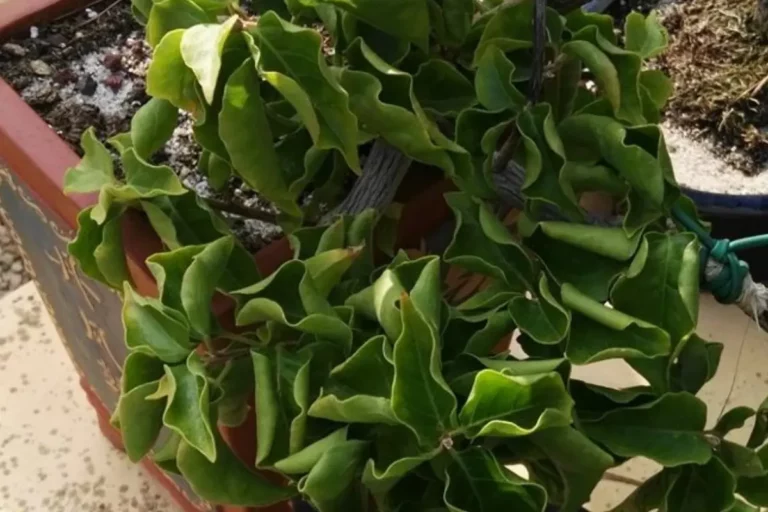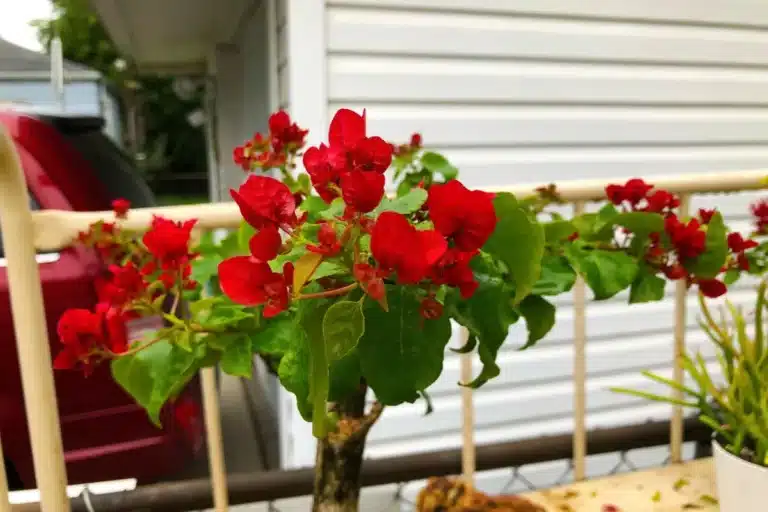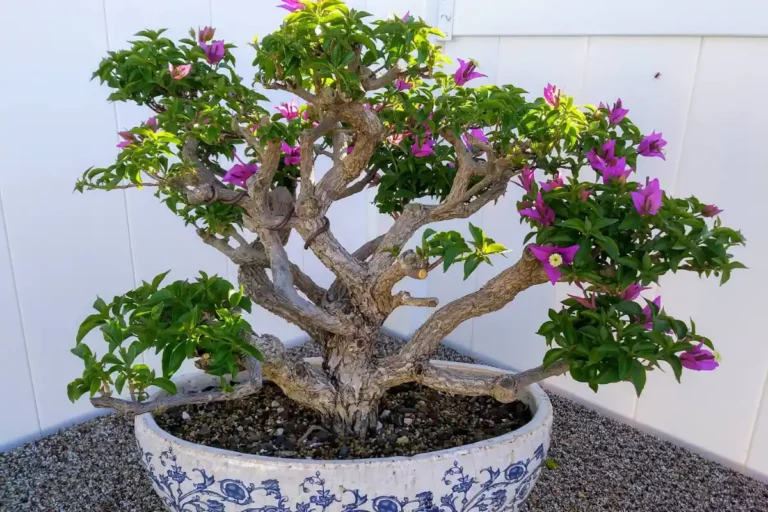Bougainvillea Leaves Turning Yellow? Reasons and Treatment
You probably know bougainvillea by the colorful flowers and heart-shaped, bright green leaves. If you have one that’s developing yellow leaves, your plant is complaining of something, and a fix is needed.
Yellowing is a sign of stress, which can be caused by a number of factors. Nutrient deficiency, overwatering, insufficient sunlight, and cold drafts can all lead to yellow foliage. Sometimes, routine practices like repotting can disturb the plant and put it into transplant shock.
If left undiagnosed and untreated, the root cause of discoloring bougainvillea leaves can kill the plant.
I’m a master gardener with extensive experience with bougainvillea. Below, I’ll guide you through troubleshooting and fixing your bougainvillea. Let’s dive in.
Why does my bougainvillea have yellow leaves?
As already stated, it is something you’re not doing right. So, it is important to review your watering habits, the amount and quality of light, nutrients, pests, etc.
Water stress
Underwatering and overwatering can stress bougainvillea, and the evidence will be seen in the foliage.
Bougainvillea is native to tropical and subtropical habitats, meaning it loves plenty of rainfall and relatively dry soils. While it is almost impossible to overwater bougainvillea, there’s a limit to how much water it can actually take at ago.
Overwatering this tropical plant leads to waterlogged soil, making it impossible for roots to take up water and nutrients or even breathe. The deprived leaves soon start to turn yellow and droop.
On the other hand, underwatering, which also means your plant isn’t getting enough water, can also lead to yellowing. The difference here (compared to overwatering) is that the leaves turn yellow and wilt at the same time.
Learn more about wilting and leaf curl in bougainvillea.
How to stop yellowing from water stress
Adjusting your watering routine is a sure way of stopping the yellowing foliage.
- To fix yellowing from underwatering, check for wilting foliage, dry soil, and an unusually light planter. These are signs the plant is thirsty. Moisten the soil with plenty of water until excess water drains out of the drainage holes in the pot. Check the plant’s soil over the following days and water when the top 2-3 of the soil is dry to the touch.
- To remedy yellowing from overwatering, stop irrigating the plant for seven days to allow the excess moisture to dry. Also, check if the soil drains poorly and amend it with compost or peat moss to improve drainage.
When traveling, I prefer shoving a watering globe into my bougainvillea pot to keep the plant hydrated for about 14 days till I return. This prevents the risk of killing the plant by drought.
You can get watering globes from Amazon or make your own from used bottles. (See video).
Underwatering your bougainvillea, especially in the dry seasons, makes the leaves turn yellow and wilt. Extreme underwatering will kill the plant.
Insufficient light
Bougainvillea loves full sunlight. That means the plant needs to receive at least six hours of direct sunlight daily to flourish. Otherwise, it will show signs of unhappiness, including yellowing foliage.
A yellowing bougainvillea is likely growing under shade or indoors a little farther away from a window.
Enough sunlight is required for photosynthesis, a process through which green plants manufacture their food. Without enough light, bougainvillea leaves, especially those at the bottom, will begin to lose their color.
In a nutshell, planting your bougainvillea in insufficient sunlight prevents it from making food and forming chlorophyll. That’s probably why you’re seeing leaves increasingly turning yellow despite your efforts to water and feed the plant.
Learn more about the best care for bougainvillea.
Diagnosing and fixing insufficient sunlight
The easiest way to tell your bougainvillea isn’t getting enough sunlight to check its health. Leggy growth, reduced flowering, and yellowing foliage are telltale signs it is deprived of enough sunlight.
The remedy is simple: place the plant in direct sunlight.
- Move potted bougainvilleas to a location with direct sunlight and temperature between 60 and 70°F. I prefer positioning these vines near a window and rotating them after a few days to expose all sides to the light. During the winter months with limited sunlight, use a grow light to illuminate the plant.
- For outdoor bougainvilleas with yellowing leaves, prune overhanging branches or broad leaves of nearby trees and shrubs blocking sunlight from reaching the plant to allow more light through.
Yellowing due to transplant shock
Moving your bougainvillea to a new location can also result in yellowing leaves. Transplanting exposes the plant to different new environmental conditions different from what it was accustomed to. The bougainvillea would find it challenging to adapt to the new conditions, which is why leaves turn yellow right after repotting.
Typically, shock occurs on three different occasions:
- When bringing a potted bougainvillea indoors just before frigid winters.
- When taking an indoor bougainvillea outside at the onset of spring or during summer for warmth bathing.
- When bringing a new bougainvillea to your home from the nursery.
Best fix
Harden the plant first before transplanting.
You can prevent yellowing leaves due to transplant shock by hardening your bougainvillea at least two weeks before the actual repotting or relocation.
Moving the plant back and forth indoors or outdoors for a few days until it acclimates to its new environment works best for me.
I recommend bringing potted bougainvilleas indoors for a few days when cold winter is near. Remember to place the plants in particularly warm rooms and return them outdoors for a few days. Repeat the cycle until they get used to their new home.
Do the same for summer and spring bathing. The yellow bougainvillea foliage is temporary. It will adjust to its new environment over time.
Cold stress
Bougainvillea prefers warm and humid conditions to thrive as a tropical plant. It performs well outdoors, remaining evergreen year-round in USDA plant hardiness zones 9b-11. Regions in these zones experience warmer winter temperatures above 30oF.
Bougainvillea develops yellow leaves when exposed to cold drafts in winter or temperatures below 40oF.
What’s the best solution?
Bring your potted bougainvillea plant indoors.
To stop yellowing leaves from cold stress, place the pots in warmer rooms. A far corner in your kitchen is ideal. Return the plant outside after winter when it’s warmer.
Pests
Spider mites are the most common pest attacking bougainvillea plants, leading to yellowing leaves. They eat the leaves and suck the plant’s sap. Heavy spider mite infestations can severely damage the plant.
These pesky intruders hide in the leaves and stems of the bougainvillea. An infested plant has small moving dots on both sides of the leaves.
Getting rid of spider mites isn’t hard before the pests become widespread: Simply hose down the plant with a jet of water, then spray it with horticultural oil.
Remove the spider mites from the plant to stop yellowing leaves. Start by pruning the damaged leaves. Rinse the remaining ones and the stems with plenty of water from a hose to eliminate the pests.
Wipe the leaves and the other plant parts with a cloth soaked in neem oil or horticultural solution to remove the spider mites, if there are many.
This fix works well for smaller varieties or bonsai bougainvillea. For larger vines, an insecticide will be more effective.
Nutrient deficiency
Bougainvillea requires nutrients in their proper quantities to grow healthy, develop new parts, and function correctly.
Fertilizing your plant regularly with enough nutrients is vital for prolific blooming and lush green foliage.
Bougainvillea leaves turn yellow when grown in soils with insufficient iron and magnesium, which are responsible for maintaining green foliage. This kind of yellowing is called chlorosis and has some distinct characteristics.
According to Brian Hudelson, a plant pathologist at the University of Wisconsin, Madison, you can identify symptoms of chlorosis in plants if you look at the leaves closely.
He says, “Affected leaves turn yellow, except for the veins, which remain green.” If this is not enough to tell the plant is suffering from iron deficiency, observe the distinct characteristics of branches and their leaves. “Symptoms can occur on isolated branches, or over an entire tree,” adds Hudelson.
How to treat nutrient deficiency in bougainvillea
The first thing you want to do is a soil test to determine the missing nutrients. Typically, the culprit is micronutrients like iron and magnesium.
Apply Epsom salt solution.
You can use bougainvillea fertilizers to boost nutrient content in the soil. I use a dilute balanced, all-purpose 10-10-10 fertilizer to feed my bougainvilleas.
Remember, fixing yellowing caused by nutrient deficiency is a long-term solution, not a quick fix.
Alternatively, Epsom salt solution is the best, immediate remedy to fix yellow leaves as it adds magnesium to the soil. I use the same Epsom salt to feed my palm trees as well and it works great.
Mix one tablespoon of Epsom salt in one gallon of water and apply the solution to the bougainvillea soil. Apply zinc chelate salt to fix yellowing from lack of zinc.
Feed your bougainvillea regularly with fertilizers after correcting yellow leaves to maintain good health.
Final thoughts
The summary table below shows the common reasons for yellowing bougainvillea leaves and their exact fixes.
| Cause | Fix |
| Water stress | Move the pot to a location with at least six hours of direct sunlight. Install a grow lamp. |
| Insufficient light | Move the pot to a location with at least six hours of direct sunlight.Install a grow lamp. |
| Transplant shock | Gradually move the plant until it acclimates to its new location. |
| Cold stress | Bring the planting pots indoors and place them in warmer rooms. |
| Pests | Hose the plant with water and wipe it with horticultural oil. |
| Nutrient deficiency | Apply Epsom salt solution and feed the plant regularly |
Overwatering and underwatering are the most common problems leading to yellowing bougainvillea leaves. Other causes include insufficient sunlight, pests, cold drafts, transplant shock, and lack of magnesium and iron.
Pay attention to these issues and fix them as recommended to prevent yellowing.
If you have any questions regarding your bougainvillea, email me your question with photos to alex@gardenine.com.




